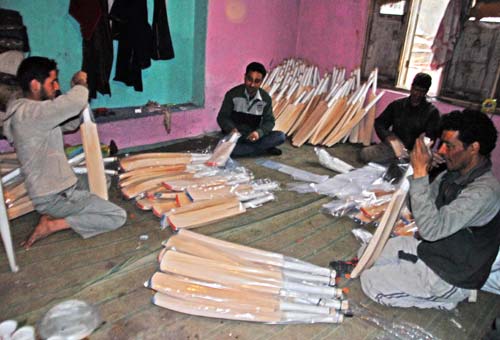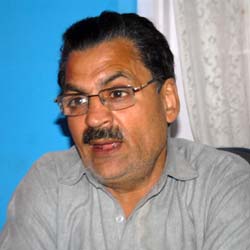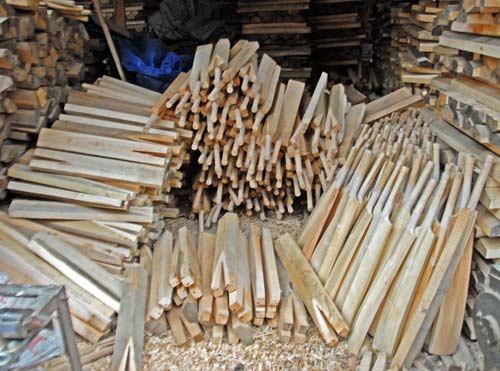The cricket bat industry of Kashmir has seen better days. As Shams Irfan reports, it’s a blend of all the wrong ingredients that’s leading to its poor performance.
 While a large section of the Kashmir population was praying for odds to turn in favour of the Pakistani cricket team in the 2011 Cricket World Cup semi finals match against India, a small business community in Kashmir knew that India’s win was their last chance to review their dwindling business.
While a large section of the Kashmir population was praying for odds to turn in favour of the Pakistani cricket team in the 2011 Cricket World Cup semi finals match against India, a small business community in Kashmir knew that India’s win was their last chance to review their dwindling business.
But they were wrong. The Indian team lifting the 2011 World Cup could not help lift their spirits or sales of cricket bats in mainland India. The losses were phenomenal as the Kashmiri cricket bat industry registered a turnover of just rupees 20 crores (from April 2011 to March 2012) as compared to rupees 98 crore (from April 2010 to March 2011) during the last season.
With the Indian team’s continuous dismal performance after it won the Cricket World Cup in March 2011, the demand for cricket bats in cricket crazy India have gone down considerably.
“This year the Indian team’s poor performance after the World Cup victory has shattered our hopes of reviving the dying cricket bat manufacturing industry,” said Nazir Ahmad Salroo, who runs a small manufacturing unit in Bijhbehara town named Salroo Sports.
“Our main market is India so the performance of the Indian cricket team on the field directly affects our sales,” he added.
“This year there has been a drastic decline in demand from our clients in Himachal Pardesh, Amritsar, Jhalandar, West Bengal, Chennai and other cricket enthusiastic parts of India because of team India’s continuous poor performance,” said Abdul Majid Dar of Alfa and Company, who owns a manufacturing unit at Sangam.
“Last year I sent around 40 thousand bats to India but this year the figures were less than half,” said Majid.
Dwindling Fortunes
But it is not just team India’s poor performance on the field that has marred the once flourishing cricket bat industry of Kashmir, official apathy and illegal transfer of raw material from Kashmir to Jhalandhar, Meerut and other parts of India where big manufactures turn it into finished product and sell them as their own product has also added to woes of the Kashmiri manufacturers.

According to Nazir Ahamd Salroo who is also president of the Cricket Bat Manufactures Association Kashmir, “Not a single Kashmiri brand has been introduced in the market so far.”
“We are killing our own business identity by selling poor imitations of world famous sporting brands like MRF, Reebok, Nike and Addidas to tourists,” he said.
Those who illegally trade in raw material use Kathua and Madhavpur as alibis to take the best of the willow cleft outside the state.
“They have set up small manufacturing units near the Jammu and Kashmir border in order to justify the transfer of fine quality willow cleft outside the valley. But in reality, they use these units as store houses from where the raw material is illegally sent outside of the state,” he informed.
“Every year around 25 crore worth of raw material is smuggled out of Kashmir and nobody is there to stop it,” said another concerned trader who wishes not to be named.
“Our losses are aggravated by the fact that only the best of the willow cleft is sent across the state borders illegally,” Nazir said.
“Smugglers often pay transportation charges as high as 2.50 lakh to send a truck load of willow clefts across the Jammu and Kashmir borders,” he said. “Some roadside vendors under the lieu of selling cricket bats to the tourists are actually selling illegal drugs at places like Charsoo and Awantipora,” he added.
Raw Material
Another factor that had led to the decline of the Kashmir bat industry is the scarcity of raw material in the valley. “It takes almost 40 years to grow a Kashmiri willow tree to its prime when it could be used as a raw material for making quality cricket bats,” Nazir said.
 “But now people prefer growing other varieties of willow like Russian poplar which take less time to grow and are profitable to a grower. The quality of our product is at stake.”
“But now people prefer growing other varieties of willow like Russian poplar which take less time to grow and are profitable to a grower. The quality of our product is at stake.”
Additionally, the growing appetite for the plywood industry in Jammu and Kashmir has pushed the demand for willow trees many folds. Thus the options for Kashmir cricket bat industry are narrowing.
In addition to cricket bats, Kashmir has the potential of manufacturing sports related leather products like cricket balls, gloves, pads and other items, as there is no dearth of raw material in Kashmir but nobody dares to venture into the trade because of corruption, legalities, and red-tape.
Limited Resources
There are around 3,000 people directly involved with this trade in Kashmir but without any proper setup in place, people are looking for other options of livelihood.
“In 1989, when the armed struggled started in Kashmir, the sports complex in Bhijbehara town was occupied by CRPF personnel and till date they have not vacated the premises,” Nazir said. “We are running our units from tin sheds instead and makeshift factories.”
“I want to export Kashmiri cricket bats to the world and create my own brand but first we need a decent place to operate from,” Nazir said.
“If things move at the same pace, the Kashmir cricket bat industry will be extinct within a year,” Majid said.















